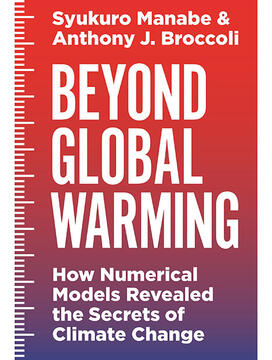Syukuro Manabe On the Scientific History of Climate Change
The book: We often hear the term “global warming” and accept it at face value, but how did the scientific community first realize humans are at the root of climate change? Syukuro Manabe, senior meteorologist in atmospheric and oceanic sciences, and Anthony J. Broccoli show how computer-driven numeric models have enabled new research to study a changing planet.
Beyond Global Warming: How Numerical Models Revealed the Secrets of Climate Change (Princeton University Press) offers a firsthand look into Manabe’s groundbreaking work alongside a thorough explanation of how global warming happens.
The authors: Syukuro Manabe is senior meteorologist in the Program in Atmospheric and Oceanic Sciences at Princeton University and a pioneer in the use of computers to simulate global climate change. Anthony J. Broccoli is professor of environmental sciences at Rutgers University.

Opening lines: There is no doubt that the composition of the atmosphere and the Earth’s climate have changed since the industrial revolution, with human activities as the predominant cause. The atmospheric concentration of carbon dioxide has increased by more than 40% since the preindustrial era, primarily from the combustion of fossil fuels for the production of energy. The global mean surface temperature, which has been relatively stable over 1,000 years, has already increased by about 1°C since the preindustrial era. If these energy production activities do not shift markedly, these changes will inevitably continue. The global mean temperature is projected to increase by an additional 2°C – 3°C during the 21st century, with land areas warming significantly more than oceans and the Arctic warming significantly more than the tropics.
The availability of water is also likely to change over the continents. Water will probably be more plentiful in already water-rich regions, increasing the rate of river discharge and frequency of floods. In contrast, water stress will increase in the subtropics and other water-poor regions that are already relatively dry, increasing the frequency of drought. Observations suggest that the frequencies of both floods and droughts have been increasing. Unless dramatic reductions of greenhouse gas emissions are achieved, global warming is likely to exert far-reaching impacts upon human society and the ecosystems of our planet during the remainder of this century and for centuries to come.
Climate models are the most powerful tools for predicting human-induced global warming. They are based upon the laws of physics and have evolved from the models used for numerical weather prediction. Exploiting the vast computational resources of some of the world’s most powerful supercomputers, climate models have been used to make predictions of future climate change and its impacts, providing valuable information for policymakers. Climate models have been useful not only for predicting climate change but also for understanding it. Serving as “virtual laboratories” of the coupled atmosphere-ocean-land system, they can be used for performing controlled experiments that have proven effective for systematically elucidating the physical mechanisms involved in climate change.
Reviews: “Syukuro Manabe has been the driving force in almost every key development regarding our understanding of the problem of carbon dioxide and climate, from ice ages to anthropogenic global warming. Beyond Global Warming is an important book by one of the towering figures of the field.” — Raymond T. Pierrehumbert, author of Principles of Planetary Climate












No responses yet